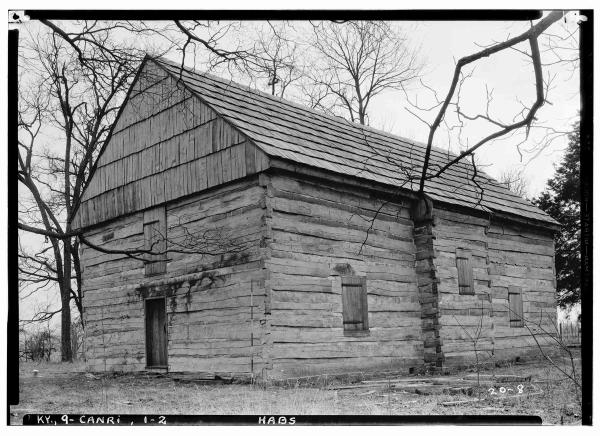“Kentucky needed a revival,” says Eddie Price, summing up the consensus among eighteenth-century clergy during his Kentucky Humanities presentation on the Cane Ridge Revival. Price is a teacher and writer who not only describes but acts out this tumultuous historical moment when the roots of the Bible Belt took hold.
Kentucky at that time was a wild frontier. The Methodist preacher Peter Cartwright described its inhabitants “as terrible people: murderers, gamblers, horse thieves, drunkards, whoremongers, fornicators, cheats, highway robbers, and counterfeiters.” He said the whole countryside was awash in tobacco spittle. Methodist Bishop Francis Asbury wrote about the settlers on a trip to Kentucky in 1794: “When I reflect that not one in a hundred came here to get religion, but rather to get plenty of good land, I think it will be well if some or many do not eventually lose their souls.”
Religion was an afterthought in the newly formed state. But that was all about to change. Between August 6 and 12, 1801, around 20,000 people (estimates range from 10,000 to 30,000) descended onto the rural Cane Ridge Meeting House in Bourbon County for what was intended to be a Presbyterian communion, a quiet weekend in which church members were supposed to pray, fast, listen to sermons, and partake in a eucharist-like ceremony. Instead, 18 to 20 ministers (mostly Presbyterian, a few fiery Methodists, and one African American Baptist) preached for six days and nights to a multitude of people camped along ten acres. The numbers are astounding but the reports of what occurred made the event legendary.
“Sinners dropping down on every hand, shrieking, groaning, crying for mercy, convoluted; professors [of religion] praying, agonizing, fainting, falling down in distress, for sinners, or in raptures of joy!” was how minister James Campbell described the scene. He continued, “Some singing, some shouting, clapping their hands, hugging and even kissing, laughing; others talking to the distressed, to one another, or to opposers of the work, and all this at once—no spectacle can excite a stronger sensation.”
Estimates of those at Cane Ridge who fell (or were slain, to use the nomenclature of the time) from the effects of religious despair or ecstasy range from 300 to 3,000. The late historian Paul Conkin, an NEH grantee and a professor at Vanderbilt University, wrote in his book Cane Ridge: America’s Pentecost, “Perhaps for the first time in American religious history, falling to the ground became almost the norm. . . . Some parts of the grounds were literally strewn like a battlefield.” “One suspects that practically everyone with an opportunity managed to get to Cane Ridge, from the governor of the state on down to farm laborers and slaves,” wrote Conkin. “It was a circus, the most exciting event in years.”
Many of the ministers and attendees documented their experiences in letters, diaries, memoirs, and journal articles, offering a bounty of first-person accounts to fill out this important early chapter of the Second Great Awakening. While researching for his historical novel Widder’s Landing, Price, a retired high school history teacher, came across numerous references and descriptions of the Cane Ridge revival, including one account by a young man named James Finley. Finley had arrived seeking entertainment, ended up converting, then went on to become a famous Methodist circuit rider in the Ohio wilderness (his NEH-funded biography by Charles C. Cole Jr. is titled Lion of the Forest: James B. Finley, Frontier Reformer). Early in his talk, Price takes on a persona based on Finley to describe the Cane Ridge scene. This composite witness reports that a preacher roared, “’If you want to be a part of this, you want to be a part of Jesus’s life—fall down!’” And then, “fifteen hundred people fell back like they had been hit by a battery of buckshot.” According to Price, Finley fled Cane Ridge and made his way to a tavern but the change in company didn’t agree with him, so he returned to the revival and became one of hundreds of new believers.
Cane Ridge “arguably remains the most important religious gathering in all of American history, both for what is symbolized and for the effects that flowed from it,” wrote Conkin. It split the Presbyterian church between Scripture-reading traditionalists who were appalled at the antics of the revival and those who wanted their church services to be emotional or “hot,” complete with physical demonstrations of the spirit. Dozens left and began new churches—such as the New Lights, Disciples of Christ, Church of Christ, and others—that spread throughout the Midwest and the South. “In time,” wrote Conkin, “the warm and communal type of Christianity that probed the boundaries of both ecstasy and propriety at Cane Ridge would predominate all over the South.”
The Cane Ridge revival made camp meetings customary for evangelical Christian denominations. The practice continues to this day, and the results can be just as dramatic. In February 2023, at Asbury University in Wilmore, Kentucky, a regularly scheduled 50-minute chapel service in the school’s Hughes Auditorium spun into a sixteen-day revival in which 50,000 students from more than 285 colleges communed in an “outpouring” of sermons, prayer, and singing. A year later, the event and its effects remain mysterious. “By definition, a revival transcends our human understanding and comprehension,” wrote Aaron Griffith in an article about Asbury in Time magazine.
These enormous faith gatherings can garner almost mythical status, just as they did two hundred years ago. New generations make pilgrimages to the original Cane Ridge church—it was restored in the 1930s and then enshrined inside a limestone structure to preserve it—wanting to experience some of the religious fire that once burned there. During one of his talks, Price remembers an elderly woman who recalled the prayer that began the camp meetings of her church in the 1950s, just as it had been repeated regularly at revivals for more than 100 years: “Lord, make it like you did at Cane Ridge.”



